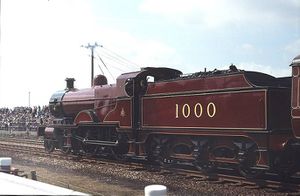Locomotives of the Midland Railway
The Midland Railway's locomotives (which it always referred to as engines), followed its small engine policy. The policy was later adopted by the London, Midland and Scottish Railway, and contrasted with the London and North Western Railway's policy. It was, perhaps, carried on too long, giving rise to the derisive poem:
- M is for Midland with engines galore
- Two on each train and asking for more
The small engine policy was partly the consequence of a difference in the background of senior managers. In most railway companies, the elite position was the design, construction and maintenance of locomotives. Bigger engines brought more prestige and allowed longer trains. In the Midland, the marketing department was paramount. They recognised that people wanted more frequent, shorter trains rather than an infreqent service. It concentrated on very light, very fast and frequent trains.
The Midland was blessed, in that George Stephenson had built its main lines with very shallow gradients. The LNWR had to cope with the hilly country north of Manchester. The Midland had also found it more efficient to use smaller, less fuel hungry locos, simply adding pilots or banking engines as necessary.
Contents
Numbering and classification
Numbering was somewhat erratic. When new locomotives took the numbers of old engines, the old engines were placed on the duplicate list and had an A suffix added to their numbers.
The Midland classified their stock into three classes numbered 1 to 3 with 1 the least powerful and three the most. Stock were also split into passenger and freight engines. Just before grouping class 4 was introduced. This system formed the basis for the subsequent LMS and BR classification systems.
See also LMS locomotive numbering and classification
Engines inherited from constituent companies
Midland formed in 1844 from the Midland Counties Railway, the North Midland Railway and the Birmingham and Derby Junction Railway, and took over a number of others including the Leicester and Swannington Railway and the Birmingham and Gloucester Railway. See
- Midland Counties Railway Locomotives
- North Midland Railway Locomotives
- Birmingham and Derby Junction Railway Locomotives
Engines built by the Midland
Initially, the Midland concentrated on maintaining and improving the somewhat varied fleet that it had inherited, with the assistance of The Railway Foundry in Leeds. In addition it bought in twenty four of their Jenny Lind locomotives.
Kirtley (1844-1873)
See Matthew Kirtley
- Midland Railway 156 Class 2-4-0
- Midland Railway 480 Class 0-6-0
- Midland Railway 700 Class 0-6-0
- Midland Railway 890 Class
Johnson (1873-1903)
See Samuel W. Johnson. Classes include:
- Midland Railway 115 Class 4-2-2 ("Midland Spinners")
- Midland Compounds 4-4-0
- Midland Railway 179 Class
- Midland Railway 483 Class
- Midland Railway 1116A Class 0-4-0ST
- Midland Railway 1377 Class 0-6-0T
- Midland Railway 1738 Class
- Midland Railway 2228 Class 0-4-4T
- Midland Railway 2441 Class 0-6-0T
Deeley (1903-1909)
See Richard Deeley
- Midland Railway 990 Class 4-4-0
- Midland Railway 1000 Class 4-4-0
- Midland Railway 1528 Class 0-4-0T
- Midland Railway 2000 Class 0-6-4T
- Midland Railway Paget locomotive 2-6-2
Fowler (1909-1923)
See Henry Fowler
Clayton
Liveries
Prior to 1883 painted green. After 1883 the Midland adopted its distinctive crimson lake livery for passenger engines, with unlined black for goods engines.
Influence on LMS locomotive policy
The LMS continued the Midland's small engine policy until William Stanier arrived in 1933. The last new Midland design was Stanier 0-4-4T of 1932/3 but some Fowler 4Fs were constructed as late as 1940.
Preservation

Five original Midland locomotives have survived, these being:
- 156 Class 2-4-0 no. 158A. (LMS 20002)
- 115 Class "Spinner" 4-2-2 no. 673
- 1000 Class "Compound" No. (4)1000
- 1377 Class "Johnson half-cab" no. (4)1708
- 4F 0-6-0 No (4)3924
In addition, there are 13 engines of two classes built by the LMS to essentially Midland designs:
- 4Fs nos (4)4027 (4)4123 and (4)4422
- 3F Jinties nos 16576/(4)7493, (4)7279 (4)7324, (4)7327, (4)7357, (4)7383 (4)7406 (4)7445 (4)7564 and (4)7298
And two engines built by the Midland for the Somerset and Dorset Joint Railway:
- S&DJR 7F 2-8-0 nos 88 and 89.
Further, there are several more engines to later non-Midland designs built at Derby which have survived.
References
- Bob Essery and David Jenkinson An illustrated review of Midland locomotives from 1883
- Vol. 1 - A general survey
- Vol. 2 - Passenger tender classes
- Vol. 3 - Tank engines
- Vol. 4 - Goods tender classes
